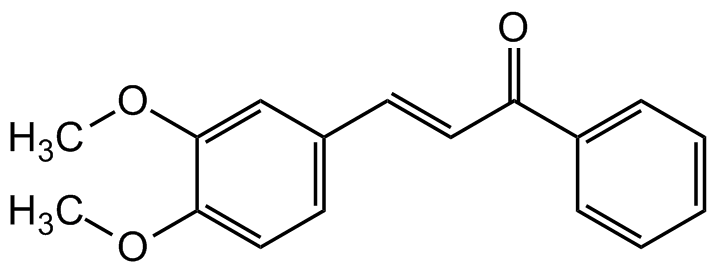
Chemical Structure
Cardamonin
CDX-C0697
CAS Number19309-14-9
Product group Chemicals
Estimated Purity>98%
Molecular Weight270.28
Overview
- SupplierChemodex
- Product NameCardamonin
- Delivery Days Customer10
- CAS Number19309-14-9
- CertificationResearch Use Only
- Estimated Purity>98%
- Hazard InformationWarning
- Molecular FormulaC16H14O4
- Molecular Weight270.28
- Scientific DescriptionCardamonin is a calchone from Aplinia species (zingiberaceous plant species) with anti-cancer and anti-inflammatory, anti-nociceptive activity. Cardamonin suppresses NF-kappa nuclear translocation and Ik-Ba phosphorylation. It has been shown to suppress nitric oxide and prostaglandin E2 synthesis, to suppress cyclooxygenase-2 expression, and to inhibit NF-kappa signaling. It induces apoptosis in cancer cells, suppresses melanogenesis by inhibition of Wnt/beta-catenin signaling and ameliorates insulin resistance. It has been shown to induce autophagy and an antiproliferative effect through JNK activation. It is an hTRPA1 antagonist and shows also anti-parasitic activity. Also shown inhibition of NLRP3 inflammasome activation via an AhR/Nrf2/NQO1 pathway. - Chemical. CAS: 19309-14-9. Formula: C16 H14 O4. MW: 270.28. Cardamonin is a calchone from Aplinia species (zingiberaceous plant species) with anti-cancer and anti-inflammatory, anti-nociceptive activity. Cardamonin suppresses NF-kappa nuclear translocation and Ik-Ba phosphorylation. It has been shown to suppress nitric oxide and prostaglandin E2 synthesis, to suppress cyclooxygenase-2 expression, and to inhibit NF-kappa signaling. It induces apoptosis in cancer cells, suppresses melanogenesis by inhibition of Wnt/beta-catenin signaling and ameliorates insulin resistance. It has been shown to induce autophagy and an antiproliferative effect through JNK activation. It is an hTRPA1 antagonist and shows also anti-parasitic activity. Also shown inhibition of NLRP3 inflammasome activation via an AhR/Nrf2/NQO1 pathway.
- SMILESO=C(C1=C(OC)C=C(O)C=C1O)/C=C/C2=CC=CC=C2
- Storage InstructionRT
- UN Number3077
- UNSPSC12352200


![(E)-Cardamonin [19309-14-9]](https://www.targetmol.com/group3/M00/02/9D/CgoaEWY7Mw-Ef6afAAAAANUpbjw640.png)
